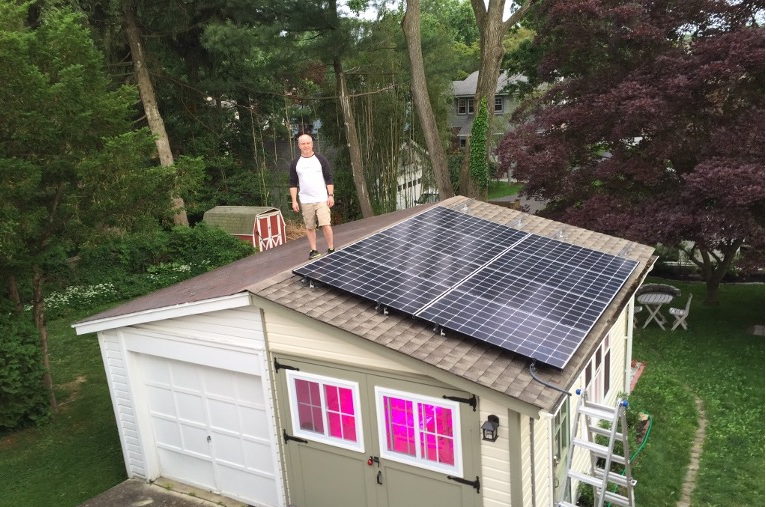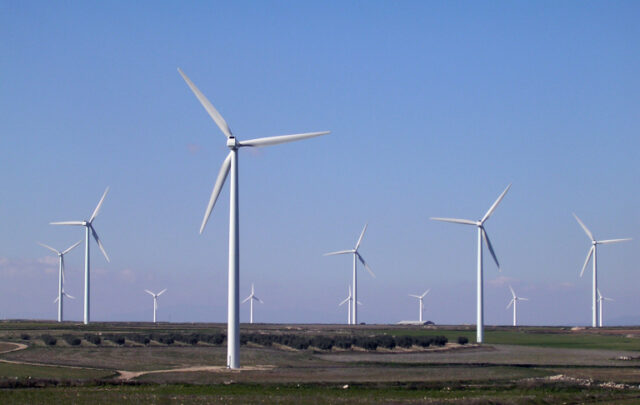I get these crazy ideas sometimes.
Actually, this one I have to blame on Joanie Freeman of Transition Charlottesville VA. Joanie was part of our Mid-Atlantic Transition Hub and shared on our monthly call that they had done a Solarize project (getting solar PV panels put on rooftops).
I thought it would be a great project for Transition Town Media, so I brought it back to our steering group, but it didn’t click. No one got excited about. I reluctantly put it on the back burner.
Same thing happened at next year’s planning session – no bites. I was pretty discouraged about it by then, but I kept thinking about it.
Next year, someone new showed up at our planning session and he admitted up front that the only reason he had come was because he wanted to do a Solarize program and he was looking for a group to partner with. Before I could do anything but grin like a kid in a candy store, one of our regular members, Joanne, said she’d be up for working on it, too. And that was that – we had our “power of 3” core team.
Three years after the seed was planted, the stars aligned, and it was a project.
Designing the Program
Together we came up with a plan. George, the new guy, had done some research before coming to us. By the time we took it on, it had been done successfully in many places around the country (with support from the US Department of Energy), so there were lots of success stories to read up on and quite a few models to choose from. (Check out the DOE Solarize Guidebook.)
We decided to really do it right. We would check out all the local installers, put out an RFP for the project, put together a rating system to select between them, evaluate them on everything from their prices to the equipment they used, to their environmental ethic. We put together a timeline for the project.
Finding the Installer
It helped a lot that George was a technical writer by profession. He did a terrific job writing the RFP and the proposal narrative form and putting together the evaluation form. Still, this part of the project took most of a year.
We started in February 2015 and finally selected our installer at the end of December. Our installer was a Philadelphia-based company, Solar States. We liked that they were a B Corp (a business that balances profit and purpose, with verified social and environmental performance, public transparency, and legal accountability). They also train and hire disadvantaged youth in the area.
Finding Our Collaborators
One recommendation we received from the DOE guidebook was to partner with a large non-profit to give the project credibility, and to partner with a local government department to help overcome policy hurdles. We were also advised to notify any entities that might have an interest in or impact on the project.
The universe aligned again! Before we could ask anyone to partner with us, the Delaware Valley Regional Planning Commission (DVRPC) approached us to ask if we would be interested in being part of a Solarize project. They had been involved in a small project with our county Planning Department and wanted to expand.
So, finding our partners turned out to be the easiest part of the process.
They helped us get a free website where our participants could enroll, learn about the project, and get in contact with us. They also advised us on the Installer RFP we were putting together. And they ran interference with the municipal code enforcement departments that we had to deal with about permitting and so on.
We also contacted local banks to see if they would be willing to give special loan deals for our customers. Our local credit union put together a loan package with attractive rates. (Read about this project from the bank’s perspective.)
Marketing and Enrollment
We decided to keep the program local to make it easier for the installer. We limited our project to a 5-mile radius around Media, which contained 14 municipalities. We went to Council meetings in all of them to introduce our project and to get their support. Some were more supportive than others but at least they all knew what to expect from us.

We organized 10 sign-up events in different towns. (See a sample of our informational flyer and our PowerPoint presentation.) We also partnered with a contractor to give half-price home energy audits to people who attended the events as an extra incentive.
The cost basis for Solarize programs typically take a tiered approach, giving bigger discounts depending on the number of participants in an area. We secured one discount for under 15 participants, a bigger one for 15-29 participants, and the largest discount for 30 or more participants.
We set a deadline for signing the solar contract, about six months after the official opening of the campaign. This was supposed to incentivize people to sign up promptly. The day before the deadline we had 28 signups; by the end of the day after the deadline we had 50.
At that point, we thought we were essentially done with the project. We would just be monitoring the installations. We planned on weekly check-ins with the installer to make sure they were progressing according to schedule and didn’t run into problems. What we didn’t expect was problems with our utility company.
Challenges the Project Faced
One of the partners we should have alerted to our project, but didn’t, was our energy supplier, PECO. They were not prepared for the influx of solar-generated power coming online. They worried about the grid’s ability to handle all the new two-way traffic, that it would cause voltage spikes and brown-outs.
PECO denied 30% of our grid connection requests and wouldn’t allow those homeowners to connect without major fixes to transformers and other equipment.
Our solar experts had to convince PECO that the voltage problems could be handled by the PV system inverters, which could be set to temporarily shut off if the voltage went over a maximum.
In the end, it took a collaboration of participants in the program, local PV installers, our state renewable energy association, and our state Public Utilities Commission to get the utility company to shift gears and see that solar was here to stay.

Eric Stein and his new solar PV installation
Outcome and Benefits
Transition Town Media volunteers helped to install solar PV panels on 43 homes, generating more than 300kW of new solar power. The project also created many local jobs in the renewable energy field. The installer had to double their staff.
We were worried that they’d have to scale back when the program was over, but another positive impact was that other Solarize programs sprang up, inspired by our success. Our installer had to expand even more.
One of the spin-offs of this project is Solarize Philly, which has installed hundreds of solar systems in the Philadelphia area. We were called in to advise them on their campaign, which is ongoing.
This project revolutionized our electric utility which, before our program, had not had to deal with much solar generation in our area. Because of our persistent pressure, the utility created a new solar energy department and revamped its procedures to work cooperatively with installers. The processes of applying for solar connection is now simpler and smoother.

Solar enabled home!
If You Want to Replicate This Project
- Pull together a committed core team of at least 3 people who are dedicated to seeing the project through and have others available to help with specific tasks as needed. Useful skills to have on tap include: organization and administrative skills, technical writing skills (if you’re creating an RFP), marketing/graphic design skills, and presentation skills. Within your collaboration, you will need folks with engineering/solar knowledge, community leaders with connections in the community, and local and county government staff.
- Build partnerships with local solar experts, your local utility company (very important!), local governments in the area where you will be doing your project, and relevant nonprofits and businesses. You will need these partners to smooth the often-rocky process of getting solar panels on homes. They can also help get the word out to different sectors.
- Don’t forget your local newspapers and other media who can help you get the word out.
- Involve your local banks and credit unions. They can help participants get home equity loans at good rates.
- Use our resources! We didn’t have to invent the wheel, and you shouldn’t have to, either. Take a look at all the resources we’ve linked to in this article. We hope they can be useful to you. You can also reach out to us with questions or advice at info@transitiontownmedia.org. We’re happy to help.





